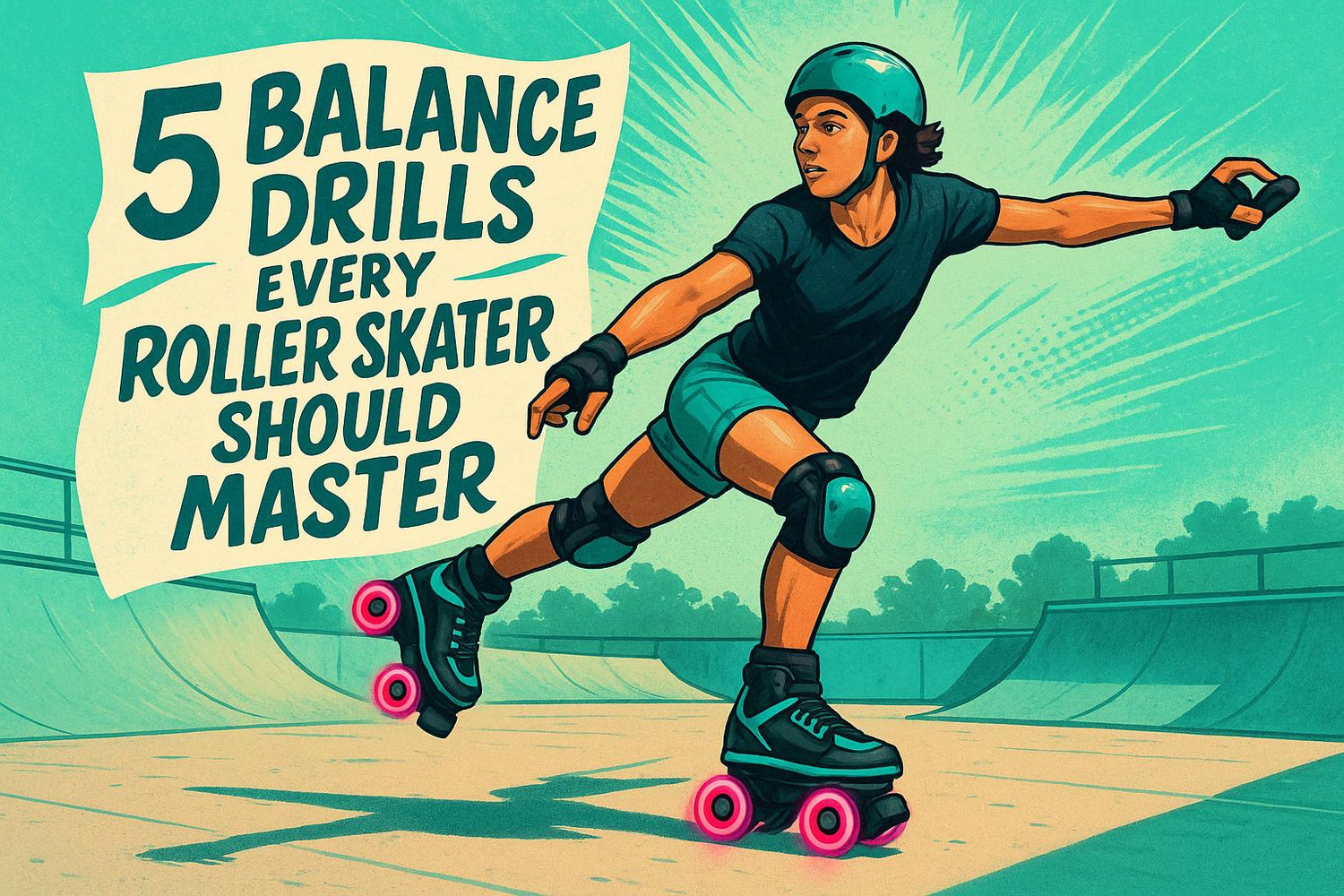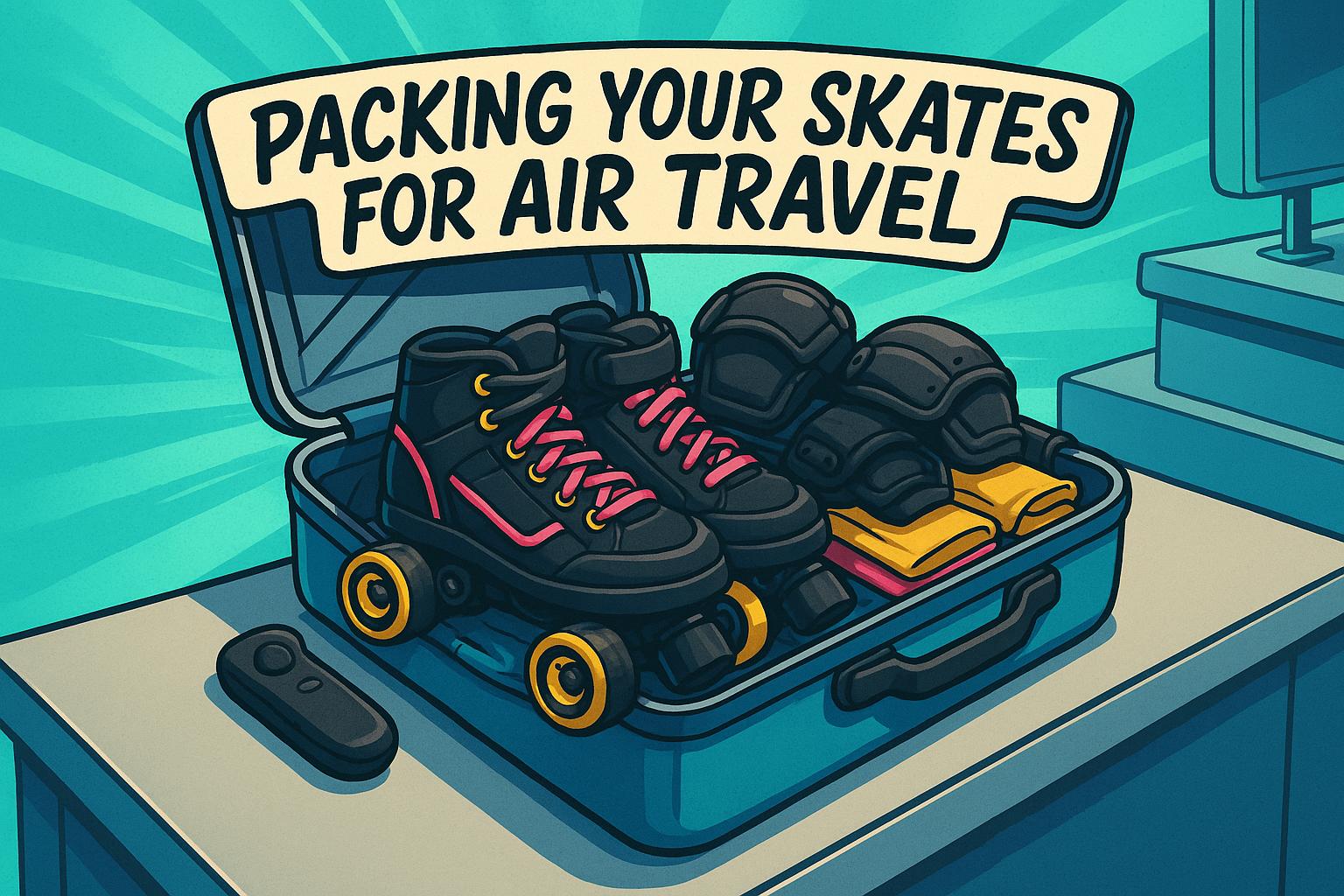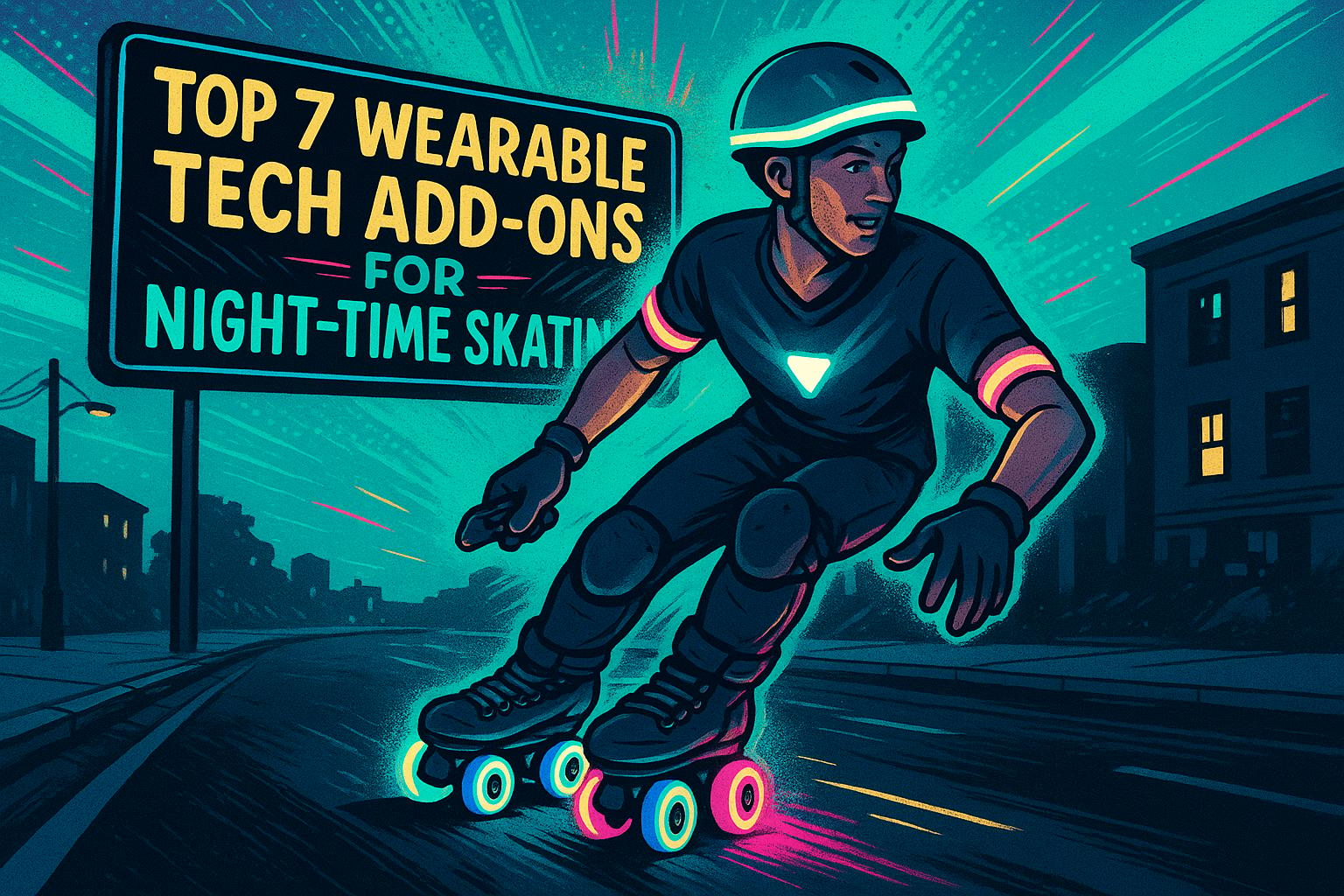Want to improve your roller skating skills and stay safe while cruising? Start with these 5 balance drills. They’re designed to help you build strength, control, and confidence - whether you’re skating manually or on electric Wheelfeet skates. Here’s a quick breakdown:
- One-Leg Balance Drill: Strengthens your core and improves stability for mounting, dismounting, and smooth transitions.
- Weight Transfer and Glide Drill: Teaches you to shift weight fluidly, building a natural skating rhythm and better control.
- Slalom or Cone Weaving Drill: Sharpens agility and precision for navigating tight spaces and urban obstacles.
- Heel-Toe Manual Drill: Improves fine motor control for slow-speed maneuvers and tight turns.
- Controlled Stop Drill (T-Stop): A reliable method for slowing down safely, complementing electric braking systems.
Each drill targets specific skills for better balance, smoother rides, and safer stops. Whether you’re a beginner or experienced skater, practicing these techniques daily (just 10–15 minutes) can significantly improve your performance. Plus, pairing these drills with Wheelfeet’s features - like regenerative braking - helps you get the most out of your skates.
Keep reading for step-by-step instructions, tips for avoiding common mistakes, and how to progress safely.
Improve Your Roller Skating w/ Balance Drills | Roller Skating Tips
Safety and Preparation Tips
Getting ready for balance drills isn’t just about jumping in; it’s about ensuring you have the right equipment and warming up your body properly. These steps are key to staying safe and getting the most out of your practice.
Protective Gear and Safe Practice Setup
When practicing balance drills, protective gear is non-negotiable. The helmet is your top priority - it shields your head and face in case of a fall. Make sure it fits snugly, sitting low on your forehead, with Y-shaped straps securely positioned below your ears.
Other must-haves include wrist guards and knee and elbow pads. These should have a hard outer shell for impact protection and a soft interior for comfort. If you’re planning more intense practice sessions, think about adding a mouthguard and padded shorts to protect your tailbone. After a fall or if your gear becomes worn, replace it immediately - especially helmets, since their integrity can be compromised.
"A warm up helps to prepare your body for physical activity. This is because it increases the heart rate, increases blood flow and warms up the muscles. A warm up can also help to prevent injury." - NHS inform
Choose your practice area wisely. Go for a flat, clean surface like smooth asphalt, concrete, or an indoor floor. Stay away from rough or debris-covered areas with sand, leaves, or water, as these can cause your skates to slip. Since practicing on hard surfaces increases the risk of injury during falls, wearing proper protective gear becomes even more critical.
Once your environment is set, it’s time to turn your attention to your skates and physical preparation.
Preparing Your Skates and Body
A secure and well-prepared setup is the foundation for success in balance drills. Start by inspecting your Wheelfeet skates. Check that they fit well, the straps are secure, and the battery is fully charged if applicable.
Equally important is warming up your body. Spend 5–10 minutes doing dynamic exercises like brisk walking, jogging, lunges, and squats to activate your core, legs, and upper body.
"A warm up exercise literally warms up your body, as in raising your temperature. It also gets the blood pumping - again, literally - revving up your cardiovascular system by increasing blood flow to the muscles." - Rainbow Rink
Ease into your warm-up gradually, starting slow and then picking up the pace. Don’t just focus on your legs - balance drills require engagement from your core and upper body, so make sure your entire body is ready for action.
Drill 1: One-Leg Balance Drill
The one-leg balance drill is all about building stability for skating. This simple yet effective exercise strengthens your core and improves muscle coordination, which are key for smooth mounting, dismounting, and controlled movements on your Wheelfeet skates.
Step-by-Step Instructions
To get started, stand near a wall or a sturdy surface for support if needed. Align your nose, knee, and toes over your standing skate. This "Nose-Knee-Toes" alignment ensures your skate wheels stay upright and provides proper balance.
Lift your free leg straight behind you. Keep your standing knee slightly bent and distribute your weight evenly across three points: the big toe, little toe, and heel. Physical therapist Samuel Chan from Bespoke Treatments highlights the importance of this "tripod stance":
"Those without midfoot control can often find it difficult to maintain a tripod stance. This refers to the foot maintaining three points of contact with the ground: the ball of the big toe, ball of the little toe and the heel."
Let your opposite arm swing naturally to help with balance. Keep your head up and focus on a point in front of you instead of looking down at your skates.
Hold this position for 15–30 seconds, then switch legs. As you improve, aim for up to 60 seconds per leg. To make it more challenging, try closing your eyes briefly or lifting your free leg higher.
Watch for common issues as you practice. A hip that drops on the opposite side can indicate weak gluteus medius muscles, while ankle wobbling suggests the need to strengthen your foot muscles. If you find yourself leaning forward, add seated thoracic extension stretches to your routine to correct your posture.
Benefits for Electric Roller Skaters
This drill directly enhances your control and confidence on Wheelfeet skates. Better single-leg balance helps with mounting and dismounting, especially when dealing with curbs, stairs, or uneven surfaces. Strengthening your gluteus medius also improves your ability to shift weight smoothly between skates.
Beyond improved control, this exercise reduces the risk of injuries. As Samuel Chan explains:
"A strong, stable foundation is necessary for pretty much all movement and can also help prevent injury."
Balance depends on the teamwork of your ears, eyes, joints, and muscles. Consistent practice sharpens this coordination. Plus, building core strength helps you stay in control during longer rides, cutting down on fatigue and boosting your confidence across different terrains.
Drill 2: Weight Transfer and Glide Drill
The weight transfer and glide drill is a great way to improve your single-leg balance while learning to shift weight between your feet with control. This movement is key to developing a natural, fluid skating rhythm on your Wheelfeet skates.
How to Perform the Drill
Start on a flat, safe surface with your feet shoulder-width apart and your knees slightly bent. Shift your weight entirely onto one foot, lifting the other foot off the ground. Hold this position briefly before transferring your weight to the opposite foot.
Keep your core and glutes engaged to maintain an upright and balanced posture during these weight shifts. Once you’re comfortable with the stationary version, move on to a gentle glide. Push off with one foot, glide on the other, and focus on keeping your movements smooth and synchronized. Let your arms swing naturally to help with balance [17, 18]. Continue alternating weight shifts as you glide.
Benefits for Wheelfeet Skaters

Practicing this drill can significantly enhance your performance on Wheelfeet skates. It boosts overall control, making it easier to handle features like adjustable speed settings and regenerative braking. Whether you’re skating in electric mode or manually, better balance and coordination lead to smoother acceleration and deceleration. With regular practice, you’ll not only improve your control but also make the most of the skates’ 9-mile range and top speed of 15 mph. This drill is a step toward a safer and more enjoyable skating experience.
Drill 3: Slalom or Cone Weaving Drill
The slalom or cone weaving drill is all about combining balance with precision. This exercise sharpens lateral agility, edge control, and coordination as you navigate obstacles in a controlled zig-zag pattern. It's a must for Wheelfeet skaters who often find themselves weaving around crowded sidewalks, parked cars, or pedestrians during their daily commutes.
Setting Up and Practicing the Drill
Setting up your slalom course is simple but requires attention to detail. Place 5 cones in a straight line on the ground. If you're just starting out, space the cones about 5 feet (1.5 meters) apart to give yourself room to practice smooth transitions. As you get more comfortable, reduce the distance between cones to challenge your precision and control.
Start by building up momentum - accelerate for about 30 feet before entering the slalom. The key technique here is the forward slalom, which uses a "scissors stance" to guide your movements. For instance, lead with your right foot to curve left around the first cone, then switch to your left foot to curve right around the next one.
Keep your movements fluid, focusing on smooth transitions and carving with the inside and outside edges of your skates. To maintain control, stay in a low stance with bent knees, which helps with quick directional changes. Vary the pressure on your feet as needed to manage your speed and direction.
For a greater challenge, advanced skaters can try the forward criss-cross slalom. This involves widening your stance to clear a cone, briefly crossing your feet while keeping them aligned, and then widening again as you approach the next cone. It’s a great way to push your coordination and edge control to the next level.
This drill builds on foundational balance exercises, preparing you for more dynamic and practical skating situations.
Improving Urban Maneuverability
The skills you develop in this drill directly translate to real-world skating scenarios. Navigating cones helps improve coordination and anticipation, which are essential when commuting through busy city streets on your Wheelfeet skates. With speeds reaching up to 15 mph, mastering edge control allows you to make sharp turns without losing stability.
The emphasis on adjusting foot pressure and maintaining support during the drill becomes especially handy when paired with Wheelfeet’s regenerative braking system. As you approach obstacles, the deceleration control you’ve practiced during slalom training helps you handle tight spaces while also conserving battery life.
sbb-itb-bf837b9
Drill 4: Heel-Toe Manual Drill
This drill takes the stability you’ve built in earlier exercises and pushes it further. The heel-toe manual drill is all about improving your fine motor control and ankle flexibility by balancing on either the heels or toes of your skates. Why does this matter? Because mastering this skill is key for handling slow-speed maneuvers and weaving through urban environments with precision.
Unlike static balance exercises, this drill challenges you to stay stable while moving. That means better control when you're navigating crowded sidewalks or making quick adjustments at speeds up to 15 mph on your electric skates.
Practicing Heel-Toe Balancing
To get started, position yourself about an arm's length from a wall or railing. This gives you something to grab onto if you lose balance, so you can focus on nailing the technique without worrying about falling.
For the toe manual, begin at a slow, rolling pace. Shift your weight forward, lift your heels slightly, and use subtle weight shifts to stay balanced. This part of the drill relies heavily on your ankle flexibility and control - small adjustments make all the difference here.
"Always keep your knees bent, chest up, and your core tight." - Gypsy, Skate Truck NYC
As you practice, keep your chin up and look forward instead of down. Good posture helps maintain balance, and extending your arms provides extra stability, letting you make small corrections as needed.
The heel manual flips the technique and cranks up the difficulty. Shift your weight backward and lift your toes. Be cautious if your skates have toe stops - don’t let your back foot drop fully downward, as this can snag the stop and throw off your balance.
Common mistakes to watch out for include uneven weight distribution and leaning too far forward. Keep your weight centered between the heel of one skate and the toe of the other. Poor posture or improper weight shifts can lead to tension and discomfort after just 10–15 minutes of practice.
Start small with 3–5 second holds, gradually increasing to 15–20 seconds as your ankle strength and core stability improve. Alternate between toe and heel manuals in short sessions to avoid overworking your muscles. With practice, these small movements will translate into better control in real-world scenarios.
Benefits for Precision Control
The heel-toe manual drill is a game changer for precision. It sharpens the micro-adjustments needed to navigate tight spaces and make accurate stops. Whether you're skating through crowded streets or dodging obstacles on your Wheelfeet skates, refined ankle control means you can make subtle course corrections without dramatic shifts in weight.
This drill also pairs perfectly with Wheelfeet’s regenerative braking system. The improved weight control you develop allows for smoother braking, helping you slow down gradually while efficiently recharging your battery.
Another bonus? You’ll gain a natural feel for edge control. Leaning inward turns you right, while leaning outward turns you left - mastering this instinctive steering makes it easier to maneuver around pedestrians, parked cars, or other urban obstacles.
On top of that, this exercise strengthens your hips, creating a solid base for all skating movements. This is especially useful when switching between electric and manual modes. Combined with the balance skills from earlier drills, this practice builds a well-rounded skill set for confident, controlled urban skating.
Drill 5: Controlled Stop Drill (T-Stop)
The T-stop is your go-to technique for safely slowing down when cruising at speeds of up to 15 mph on your Wheelfeet skates. By forming a T-shape with your skates, you use the friction from your braking skate to control your deceleration. Unlike more forceful stopping methods, the T-stop offers a smoother, more controlled way to slow down - perfect for navigating crowded sidewalks or approaching intersections during your commute.
Why is this drill so important? The T-stop isn’t just about stopping; it’s a full-body effort. It requires strength and stability in your legs and core to counteract the friction generated by the wheels during braking. Mastering this technique not only makes you a safer skater but also builds the muscle control and balance that improve your overall skating skills.
Learning the T-Stop Technique
Start slow. Practicing at lower speeds allows you to focus on form and build confidence before tackling faster scenarios. The T-stop is broken into several key phases, each essential for mastering the technique.
Phase one and two: Begin by gliding on one foot, keeping your free leg positioned either beside or slightly behind your skating leg. Once you feel stable, move your free leg behind your gliding foot to prepare for the stop. Throughout this, keep your shoulders and hips aligned and square.
Phase three: Place your free leg down perpendicular to your gliding leg, forming a T-shape. Make sure all four wheels of your braking skate touch the ground and apply gradual pressure to create friction. Focus on the outside wheels making contact while keeping your shoulders and hips steady.
One common mistake is failing to shift your weight fully onto the gliding foot, which reduces stopping power. To improve, practice extended single-foot gliding to enhance your stability and weight distribution. Another frequent issue is twisting at the knee or ankle instead of rotating from the hip. Think of "opening a book" from your groin to your toes, ensuring the rotation happens at your hip joint. Keep your upper body still - any unnecessary movement in your head or shoulders can throw off your balance and reduce the effectiveness of your stop.
Position your braking foot as close as possible to your weight-bearing foot when initiating the T-stop. This keeps your weight evenly distributed and minimizes unnecessary wear on your wheels. Maintain this position until you come to a complete stop.
Don’t forget to practice on both sides, alternating which leg acts as the braking leg. This bilateral training prepares you to stop effectively no matter the situation, whether it’s dodging a sudden obstacle or adjusting to traffic patterns in urban environments.
Integrating with Wheelfeet Features
The T-stop pairs seamlessly with the advanced features of Wheelfeet skates. For instance, while you’re creating friction with the T-stop, Wheelfeet’s regenerative braking system captures energy from your deceleration and channels it back into the battery, helping to extend your 9-mile range. This combination ensures smooth, energy-efficient stops.
To refine your stopping precision, practice combining the T-stop with Wheelfeet’s regenerative braking and remote control. Start by engaging the regenerative braking gently through the remote, then layer in the T-stop for additional control. This approach is especially useful in tight spaces, like crowded sidewalks or when approaching traffic lights, where precise stopping is key.
Begin by mastering the T-stop in manual mode, focusing solely on your technique. As you gain confidence, incorporate the electric features gradually. This progression not only builds muscle memory but also ensures you’re prepared to stop effectively in emergencies - whether or not your battery is fully charged or electronic assistance is available.
Tips for Progress and Safety
Progressing with Wheelfeet skates requires patience and smart practice. Many skaters make the mistake of rushing or picking up bad habits that can hold them back.
Common Mistakes to Avoid
- Locking your knees: Always keep them slightly bent. This helps with shock absorption and keeps your stance flexible.
- Poor posture: Balance starts with proper alignment. Keep your hips over your feet and your eyes looking forward.
- Tension in your body: Staying too stiff can throw off your balance. Relax and let your movements flow naturally.
- Skipping foundational drills: You need to master the basics before diving into advanced maneuvers.
- Ill-fitting skates: Make sure your skates fit properly to avoid unnecessary struggles.
Strategies for Skill Progression
- Start small: Begin with static drills, like marching in place, to get used to the skates and how your weight shifts.
- Practice consistently: Dedicate 10–15 minutes each day to build muscle memory.
- Increase difficulty gradually: Extend the time spent on drills, reduce reliance on walls or railings, and add complexity to movements you’ve already learned.
- Adjust speed settings: Use Wheelfeet's adjustable speed settings. Start at the lowest speed and increase it as you gain confidence.
- Set micro-goals: For example, aim to glide on one foot for eight seconds to track improvement.
- Train off the skates: Add exercises like planks, single-leg stands, or balance board routines for 5–10 minutes daily to strengthen your core and enhance stability.
- Balance both sides: Practice equally on your left and right to prepare for unexpected situations.
These steps ensure a smoother transition from practice drills to real-world skating scenarios.
Comparison Table of Drills and Benefits
Here’s a quick breakdown of drills, their benefits, and how they apply to Wheelfeet skating:
| Drill | Primary Benefit | Wheelfeet Application | Difficulty Level | Duration |
|---|---|---|---|---|
| One-Leg Balance | Core stability, weight distribution | Prepares for regenerative braking transitions | Beginner | 30 seconds per leg |
| Weight Transfer & Glide | Smooth transitions, momentum control | Improves cruising efficiency | Beginner-Intermediate | 2–3 minutes |
| Slalom/Cone Weaving | Agility, precise steering | Navigates urban obstacles | Intermediate | 5–10 passes |
| Heel-Toe Manual | Advanced balance, board control | Helps with tight-space maneuvering | Intermediate-Advanced | 15–30 seconds |
| T-Stop | Controlled deceleration, safety | Complements regenerative braking | Intermediate | Until complete stop |
Stick to smooth, flat surfaces while practicing, and use external support if needed. If you’re struggling with certain techniques, consider working with a professional instructor for personalized guidance and feedback.
Conclusion: Mastering Balance for a Better Skating Experience
Hone these five drills to skate confidently and stay in control on your Wheelfeet electric skates. The one-leg balance drill strengthens your core, making regenerative braking transitions smoother. Weight transfer and glide techniques help you skate more efficiently, conserving energy and extending battery life. Slalom weaving equips you to navigate urban obstacles like pedestrians, street furniture, and uneven terrain. The heel-toe manual sharpens your precision in tight spaces, while the T-stop gives you a dependable alternative to your electric braking system. Together, these exercises enhance both your technical skills and your confidence for tackling city skating challenges.
"Consistency is key: Incorporate roller skating into your regular fitness routine for consistent calorie burning." - Rainbow Skateland
Dedicate 10–15 minutes a day to practice, focusing on one or two drills at a time. This approach helps you build muscle memory without feeling overwhelmed. Start with Wheelfeet's lowest speed setting and gradually increase it as your skills improve.
"Progressive challenge: Gradually increase the intensity and duration of your skating sessions to continually challenge your body." - Rainbow Skateland
FAQs
How can I tell if my protective gear is still effective, and when should I replace it?
To keep your protective gear doing its job, make it a habit to check for any damage. Look for things like cracks, frayed straps, or padding that's lost its shape or firmness. If something doesn’t fit snugly or no longer covers you properly, it’s time to swap it out.
It’s also smart to replace gear after a major impact, even if it looks fine on the outside - materials can weaken without obvious signs. For helmets, always check for certification labels and stick to the manufacturer’s recommendations. Most suggest replacing helmets every 5 years, even if they haven’t been in an accident, as materials naturally break down over time.
What mistakes should I avoid when practicing balance drills for roller skating?
When working on balance drills, steer clear of a few common missteps. For starters, keep your knees slightly bent instead of locking them straight. Straight knees make it much harder to stay steady. Also, keep your head up and your gaze forward - looking down at your feet can mess with your posture and throw off your balance.
Another frequent mistake is holding too much tension in your body. Stay relaxed and let your movements feel natural; being too stiff can disrupt your stability. Finally, don’t rush. Take your time to focus on each movement and get the technique right. This not only improves your results but also helps prevent injuries.
What’s the best way to include these balance drills in my skating routine to improve steadily?
To see steady progress, make these balance drills a regular part of your skating routine. Aim to practice them 3–4 times a week, paying close attention to maintaining proper form and control. Begin with shorter sessions, then gradually extend the duration as your balance gets better.
Another option is to include these drills in your warm-up or cool-down, making them an easy and natural addition to your routine. The secret is consistency - regular practice will help develop muscle memory, enhance stability, and increase your confidence on skates.




Leave a comment
All comments are moderated before being published.
This site is protected by hCaptcha and the hCaptcha Privacy Policy and Terms of Service apply.